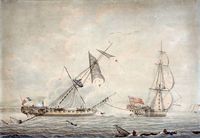Notorious enemy at sea: France
Notorious enemy at sea: France
Notorious enemy at sea: France
The question whether Maria Theresa was the rightful heir to the throne ignited a war in 1740 that was also fought at sea - virtually worldwide. In a case study, the Prize Papers project focuses on ships captured from the colonial power France during that conflict.
On land, the houses of Habsburg and Hanover, Great Britain and the Netherlands fought Prussia, Bavaria, France and Spain in the War of the Austrian Succession. On the world's oceans, on the other hand, it was mainly the great colonial powers France and Great Britain that were engaged in the conflict from 1744 until the Habsburg Maria Theresa was confirmed as empress in 1748. "The naval wars of the time were about supremacy at sea – in European waters as well as overseas," says Lisa Magnin. Together with her colleague Daniel Fleisch, the researcher in the Prize Papers project took the lead in compiling the documents that have now been published on the project portal for the first time.
Capturing the ships of hostile powers was considered a legitimate means of warfare – the fact that a good portion of the documents stored in the Prize Papers holdings at the National Archives in London come from French ships is no coincidence given this pronounced rivalry. During the four years in which both sides fought each other at sea during the War of the Austrian Succession alone, French privateers captured 3238 British ships – and in turn lamented the loss of 3434 ships to British privateers.
Of the latter, ten are the focus of the case study now published by the project team, which presents three of the ships in detail, including some transcriptions of original sources. Since these captures were among those whose legality was disputed before the British admiralty jurisdiction, various documents from on board – which served as evidence at the time – have survived to this day.
Whether a nearly 200-year-old mathematics book with which a captain from Bordeaux practised text problems, the basics of bookkeeping and the calculation of exchange rates; whether the letter of complaint from a plantation owner from Martinique who saw his freedom curtailed because he was not allowed to take the enslaved people in his possession with him when he moved to what was then Nouvelle Orléans (today's New Orleans); or whether the love letter that set out from Bayonne on its journey across the Atlantic with the drawing of a heart pierced by arrows: The range of documents, now published online for the first time, is wide.

"The case study gives a good first overview of the different types of documents that used to be on ships – and invites further research," says Daniel Fleisch. There are many ways to research the ships in the project’s portal. For example, the court records and ship's papers shed light on the war at sea and its consequences, on legal practice and diplomacy in the mid-18th century. They also offer insight into French ports and the global trade in tools or straw hats, orange blossom water or ivory, for example. Letters from traders, sailors, between husbands and wives, business partners or friends dealt with an enormous range of topics – and thus provide new perspectives on French history.
Further case studies are planned for the course of the year – for example, one on ships that sailed under a neutral flag but still did not escape capture.




